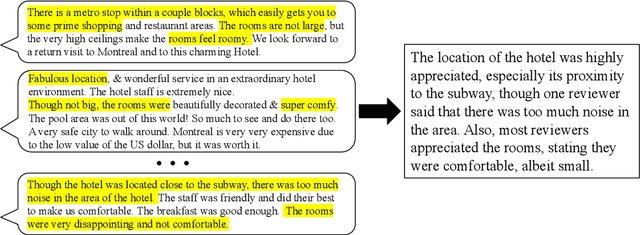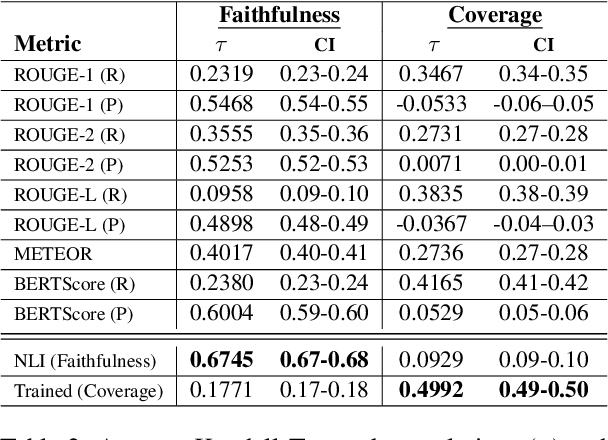Aviv Slobodkin
A Unifying Scheme for Extractive Content Selection Tasks
Jul 22, 2025Abstract:A broad range of NLP tasks involve selecting relevant text spans from given source texts. Despite this shared objective, such \textit{content selection} tasks have traditionally been studied in isolation, each with its own modeling approaches, datasets, and evaluation metrics. In this work, we propose \textit{instruction-guided content selection (IGCS)} as a beneficial unified framework for such settings, where the task definition and any instance-specific request are encapsulated as instructions to a language model. To promote this framework, we introduce \igcsbench{}, the first unified benchmark covering diverse content selection tasks. Further, we create a large generic synthetic dataset that can be leveraged for diverse content selection tasks, and show that transfer learning with these datasets often boosts performance, whether dedicated training for the targeted task is available or not. Finally, we address generic inference time issues that arise in LLM-based modeling of content selection, assess a generic evaluation metric, and overall propose the utility of our resources and methods for future content selection models. Models and datasets available at https://github.com/shmuelamar/igcs.
RefVNLI: Towards Scalable Evaluation of Subject-driven Text-to-image Generation
Apr 24, 2025Abstract:Subject-driven text-to-image (T2I) generation aims to produce images that align with a given textual description, while preserving the visual identity from a referenced subject image. Despite its broad downstream applicability -- ranging from enhanced personalization in image generation to consistent character representation in video rendering -- progress in this field is limited by the lack of reliable automatic evaluation. Existing methods either assess only one aspect of the task (i.e., textual alignment or subject preservation), misalign with human judgments, or rely on costly API-based evaluation. To address this, we introduce RefVNLI, a cost-effective metric that evaluates both textual alignment and subject preservation in a single prediction. Trained on a large-scale dataset derived from video-reasoning benchmarks and image perturbations, RefVNLI outperforms or matches existing baselines across multiple benchmarks and subject categories (e.g., \emph{Animal}, \emph{Object}), achieving up to 6.4-point gains in textual alignment and 8.5-point gains in subject consistency. It also excels with lesser-known concepts, aligning with human preferences at over 87\% accuracy.
EventFull: Complete and Consistent Event Relation Annotation
Dec 17, 2024



Abstract:Event relation detection is a fundamental NLP task, leveraged in many downstream applications, whose modeling requires datasets annotated with event relations of various types. However, systematic and complete annotation of these relations is costly and challenging, due to the quadratic number of event pairs that need to be considered. Consequently, many current event relation datasets lack systematicity and completeness. In response, we introduce \textit{EventFull}, the first tool that supports consistent, complete and efficient annotation of temporal, causal and coreference relations via a unified and synergetic process. A pilot study demonstrates that EventFull accelerates and simplifies the annotation process while yielding high inter-annotator agreement.
GRADE: Quantifying Sample Diversity in Text-to-Image Models
Oct 29, 2024



Abstract:Text-to-image (T2I) models are remarkable at generating realistic images based on textual descriptions. However, textual prompts are inherently underspecified: they do not specify all possible attributes of the required image. This raises two key questions: Do T2I models generate diverse outputs on underspecified prompts? How can we automatically measure diversity? We propose GRADE: Granular Attribute Diversity Evaluation, an automatic method for quantifying sample diversity. GRADE leverages the world knowledge embedded in large language models and visual question-answering systems to identify relevant concept-specific axes of diversity (e.g., ``shape'' and ``color'' for the concept ``cookie''). It then estimates frequency distributions of concepts and their attributes and quantifies diversity using (normalized) entropy. GRADE achieves over 90% human agreement while exhibiting weak correlation to commonly used diversity metrics. We use GRADE to measure the overall diversity of 12 T2I models using 400 concept-attribute pairs, revealing that all models display limited variation. Further, we find that these models often exhibit default behaviors, a phenomenon where the model consistently generates concepts with the same attributes (e.g., 98% of the cookies are round). Finally, we demonstrate that a key reason for low diversity is due to underspecified captions in training data. Our work proposes a modern, semantically-driven approach to measure sample diversity and highlights the stunning homogeneity in outputs by T2I models.
Explicating the Implicit: Argument Detection Beyond Sentence Boundaries
Aug 08, 2024



Abstract:Detecting semantic arguments of a predicate word has been conventionally modeled as a sentence-level task. The typical reader, however, perfectly interprets predicate-argument relations in a much wider context than just the sentence where the predicate was evoked. In this work, we reformulate the problem of argument detection through textual entailment to capture semantic relations across sentence boundaries. We propose a method that tests whether some semantic relation can be inferred from a full passage by first encoding it into a simple and standalone proposition and then testing for entailment against the passage. Our method does not require direct supervision, which is generally absent due to dataset scarcity, but instead builds on existing NLI and sentence-level SRL resources. Such a method can potentially explicate pragmatically understood relations into a set of explicit sentences. We demonstrate it on a recent document-level benchmark, outperforming some supervised methods and contemporary language models.
Visual Riddles: a Commonsense and World Knowledge Challenge for Large Vision and Language Models
Jul 28, 2024Abstract:Imagine observing someone scratching their arm; to understand why, additional context would be necessary. However, spotting a mosquito nearby would immediately offer a likely explanation for the person's discomfort, thereby alleviating the need for further information. This example illustrates how subtle visual cues can challenge our cognitive skills and demonstrates the complexity of interpreting visual scenarios. To study these skills, we present Visual Riddles, a benchmark aimed to test vision and language models on visual riddles requiring commonsense and world knowledge. The benchmark comprises 400 visual riddles, each featuring a unique image created by a variety of text-to-image models, question, ground-truth answer, textual hint, and attribution. Human evaluation reveals that existing models lag significantly behind human performance, which is at 82\% accuracy, with Gemini-Pro-1.5 leading with 40\% accuracy. Our benchmark comes with automatic evaluation tasks to make assessment scalable. These findings underscore the potential of Visual Riddles as a valuable resource for enhancing vision and language models' capabilities in interpreting complex visual scenarios.
Is It Really Long Context if All You Need Is Retrieval? Towards Genuinely Difficult Long Context NLP
Jun 29, 2024Abstract:Improvements in language models' capabilities have pushed their applications towards longer contexts, making long-context evaluation and development an active research area. However, many disparate use-cases are grouped together under the umbrella term of "long-context", defined simply by the total length of the model's input, including - for example - Needle-in-a-Haystack tasks, book summarization, and information aggregation. Given their varied difficulty, in this position paper we argue that conflating different tasks by their context length is unproductive. As a community, we require a more precise vocabulary to understand what makes long-context tasks similar or different. We propose to unpack the taxonomy of long-context based on the properties that make them more difficult with longer contexts. We propose two orthogonal axes of difficulty: (I) Diffusion: How hard is it to find the necessary information in the context? (II) Scope: How much necessary information is there to find? We survey the literature on long-context, provide justification for this taxonomy as an informative descriptor, and situate the literature with respect to it. We conclude that the most difficult and interesting settings, whose necessary information is very long and highly diffused within the input, is severely under-explored. By using a descriptive vocabulary and discussing the relevant properties of difficulty in long-context, we can implement more informed research in this area. We call for a careful design of tasks and benchmarks with distinctly long context, taking into account the characteristics that make it qualitatively different from shorter context.
The Power of Summary-Source Alignments
Jun 02, 2024Abstract:Multi-document summarization (MDS) is a challenging task, often decomposed to subtasks of salience and redundancy detection, followed by text generation. In this context, alignment of corresponding sentences between a reference summary and its source documents has been leveraged to generate training data for some of the component tasks. Yet, this enabling alignment step has usually been applied heuristically on the sentence level on a limited number of subtasks. In this paper, we propose extending the summary-source alignment framework by (1) applying it at the more fine-grained proposition span level, (2) annotating alignment manually in a multi-document setup, and (3) revealing the great potential of summary-source alignments to yield several datasets for at least six different tasks. Specifically, for each of the tasks, we release a manually annotated test set that was derived automatically from the alignment annotation. We also release development and train sets in the same way, but from automatically derived alignments. Using the datasets, each task is demonstrated with baseline models and corresponding evaluation metrics to spur future research on this broad challenge.
Attribute First, then Generate: Locally-attributable Grounded Text Generation
Apr 01, 2024Abstract:Recent efforts to address hallucinations in Large Language Models (LLMs) have focused on attributed text generation, which supplements generated texts with citations of supporting sources for post-generation fact-checking and corrections. Yet, these citations often point to entire documents or paragraphs, burdening users with extensive verification work. In this paper, we introduce a locally-attributable text generation approach, prioritizing concise attributions. Our method, named ``Attribute First, then Generate'', breaks down the conventional end-to-end generation process into three intuitive steps: content selection, sentence planning, and sequential sentence generation. By initially identifying relevant source segments (``select first'') and then conditioning the generation process on them (``then generate''), we ensure these segments also act as the output's fine-grained attributions (``select'' becomes ``attribute''). Tested on Multi-document Summarization and Long-form Question-answering, our method not only yields more concise citations than the baselines but also maintains - and in some cases enhances - both generation quality and attribution accuracy. Furthermore, it significantly reduces the time required for fact verification by human assessors.
Multi-Review Fusion-in-Context
Mar 31, 2024



Abstract:Grounded text generation, encompassing tasks such as long-form question-answering and summarization, necessitates both content selection and content consolidation. Current end-to-end methods are difficult to control and interpret due to their opaqueness. Accordingly, recent works have proposed a modular approach, with separate components for each step. Specifically, we focus on the second subtask, of generating coherent text given pre-selected content in a multi-document setting. Concretely, we formalize Fusion-in-Context (FiC) as a standalone task, whose input consists of source texts with highlighted spans of targeted content. A model then needs to generate a coherent passage that includes all and only the target information. Our work includes the development of a curated dataset of 1000 instances in the reviews domain, alongside a novel evaluation framework for assessing the faithfulness and coverage of highlights, which strongly correlate to human judgment. Several baseline models exhibit promising outcomes and provide insightful analyses. This study lays the groundwork for further exploration of modular text generation in the multi-document setting, offering potential improvements in the quality and reliability of generated content. Our benchmark, FuseReviews, including the dataset, evaluation framework, and designated leaderboard, can be found at https://fusereviews.github.io/.
 Add to Chrome
Add to Chrome Add to Firefox
Add to Firefox Add to Edge
Add to Edge